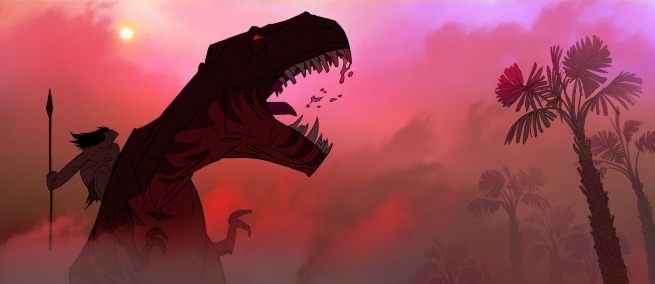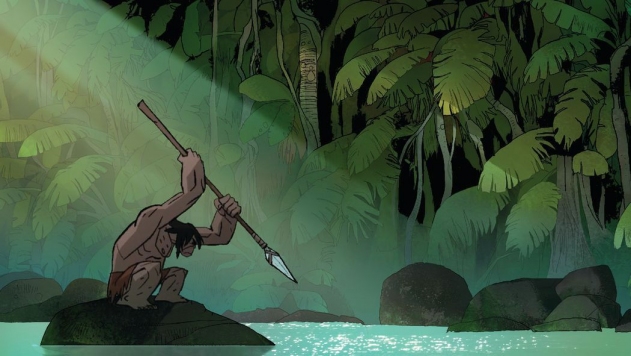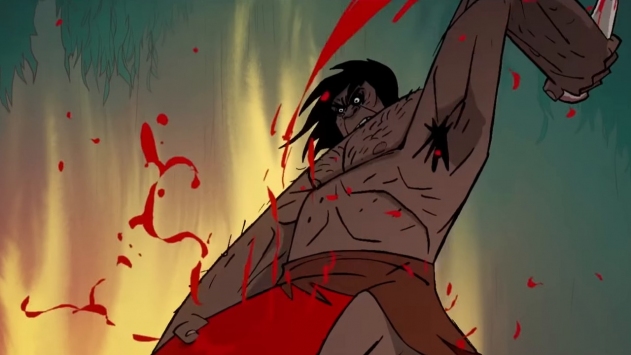
The remarkable new Adult Swim animated series GENNDY TARTAKOVSKY’S PRIMAL follows the evolution of an unexpected friendship between a caveman and a dinosaur. Set in prehistoric times, the show is completely without dialogue, making its visual aesthetics all the more crucial to the storytelling. We spoke with art director Scott Wills, who first collaborated with Genndy Tartakovsky on the Emmy award-winning series SAMURAI JACK.
The first six episodes of season one of PRIMAL are available to watch on Adult Swim and HBO Max, and the next four are premiering on successive Sundays, including this Sunday, October 11. The series has also been renewed for a second season.
Science & Film: What does your job as art director on PRIMAL entail?
Scott Wills: The main thing I do is paint all of the environments, color the characters, and then I put effects, color, and light together. On PRIMAL it’s amazing because without dialogue the story is told visually more than ever. You usually don’t get the kind of opportunity where art, music, and sound are so crucial to telling the story. It’s fantastic as an art director.
S&F: The colors in PRIMAL are at times very realistic, and at other times completely not—like green blood. What informs those decisions?
SW: I’ve worked with Genndy for a long time, twenty years. We always try to do very bold and unexpected colors—basically not realistic; any time I have a realistic solution, that’s not good for Genndy. But this show, compared to something like SAMURAI JACK which is a very stylized show with crazy color, this show is so much more grounded in reality. Christian [Schellewald], who draws the show, is very organic and illustrative so it pulls me toward more realistic color. I struggle with that a lot because Genndy always wants some crazy color statement that shocks you [laughs]. I get to hit that sometimes, but overall the show is more real than some of our other work.
S&F: What did you use as source material or inspiration for the colors?
SW: When we were first starting the show, Genndy and I were watching a lot of nature documentaries, though not really with PRIMAL in mind. One was called THE HUNT and we were marveling at how amazing and beautiful it was and said, god, if we could do something like that in animation… That actually became a huge inspiration for PRIMAL. [These documentaries] have a narrator, like David Attenborough, but still manage to tell a story visually. So I was looking at nature photography. Usually I’m looking at other painters, like Frank Frazetta, but I was surprised by how inspiring this real stuff was.
S&F: When you were watching these nature documentaries, what was it about the prospect of doing something similar in animation that was exciting to you?
SW: There is something for me about telling a story through drawing and painting that has its own magic and suspended reality. It’s completely different than something that’s live action. With drawings and paintings, you have leeway to do more fantastic things; it’s a different reality and it’s very fun to work in that world.
S&F: How did your relationship with Genndy begin?
SW: We started working together on a show called SAMURAI JACKin 2000 or 2001. That was a great show, very experimental and stylized. I actually quit a feature job a DreamWorks to work on SAMURAI JACK—it’s kind of unheard of to do that, but I asked Genndy at the beginning, we’re not going to be trapped into one look, something very formulaic, are we? And he said, no! We can try stuff from episode to episode, there are no rules. That’s what’s great about Genndy; he’s very open and is constantly changing. We’ve done a lot of TV shows and they all look different. They have our same sensibilities overall, but we’re always trying to give each show its own visual identity. I’m really proud that PRIMAL has its own unique look.

Genndy’s storyboarding is on a whole other level than anybody in the business. It’s astounding when you see his storyboards.
S&F: At what point in the process do you come in?
SW: Once the storyboard is done, Christian starts to drawn the environment, then I start painting and working with the characters. It’s basically us three plus a character designer. It’s an incredibly small team. If you look at the end credits, it’s literally four or five people [laughs]. It’s crazy, we’ve never had such a small crew. On top of it, everyone just works at home.
S&F: Was such a small crew meant to serve the project in some way?
SW: Not really, it just happened. I think because Genndy’s storyboarding is getting so good and what we’re going for, especially for television, is so ambitious that it’s hard to find anybody that will do what we want so we just end up doing most of it ourselves. Genndy is insanely involved. He is working harder than anybody. No detail is too small for him to fix.

One thing I love about TV is that it’s much lower budget than features plus we have this tiny crew that makes you prouder of the work if you’re able to pull off. If you can pull off something that effects people and that people marvel at, that’s much more satisfying than a 100-million-dollar feature—of course that’s going to look good! Plus, we don’t have people questioning every decision. On PRIMAL it’s almost complete freedom so that’s amazing.
S&F: Is there anything in the future of the show that you’re particularly looking forward to?
SW: It starts changing. I can’t say anything about the story, but it doesn’t stay in the same rut. I can imagine people thinking: they do this each episode. It really changes which is great. Genndy is trying to push the story. I’m excited to get even more adult and more fantastic.
♦
GENNDY TARTAKOVSKY’S PRIMAL has already won three Primetime Emmy awards for Outstanding Individual Achievement in Animation. The first five episodes are available to watch on Adult Swim and HBO Max, with the next five premiering on Adult Swim starting October 4. Scott Wills’s other work includes SAMURAI JACK, THE REN & STIMPY SHOW, and STAR WARS: CLONE WARS.
TOPICS